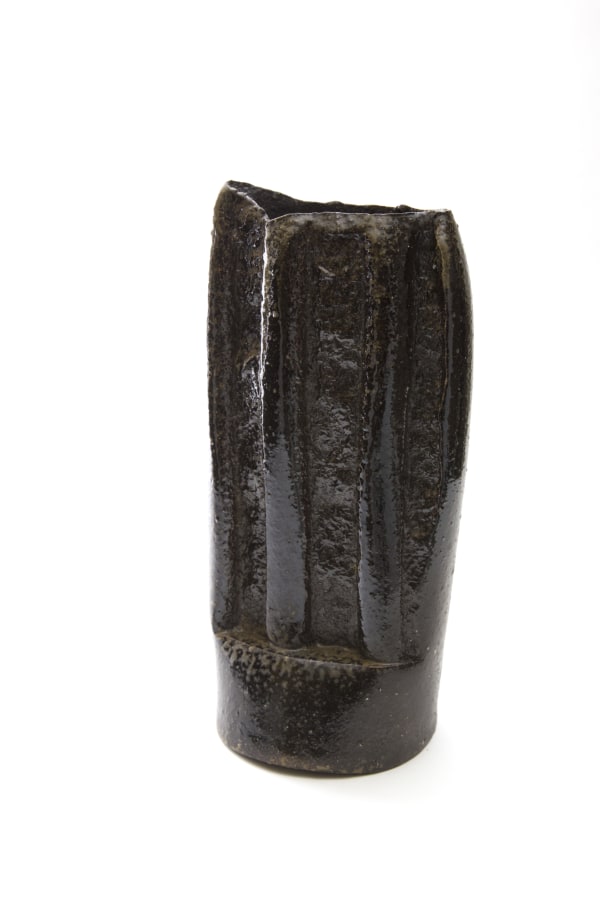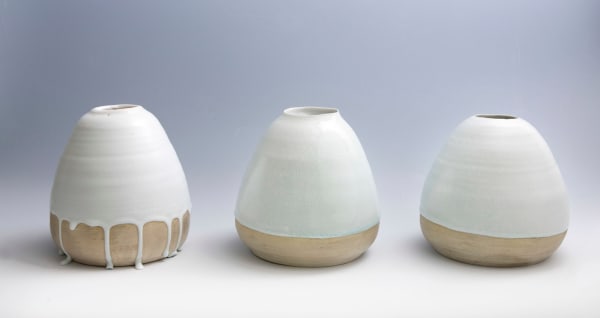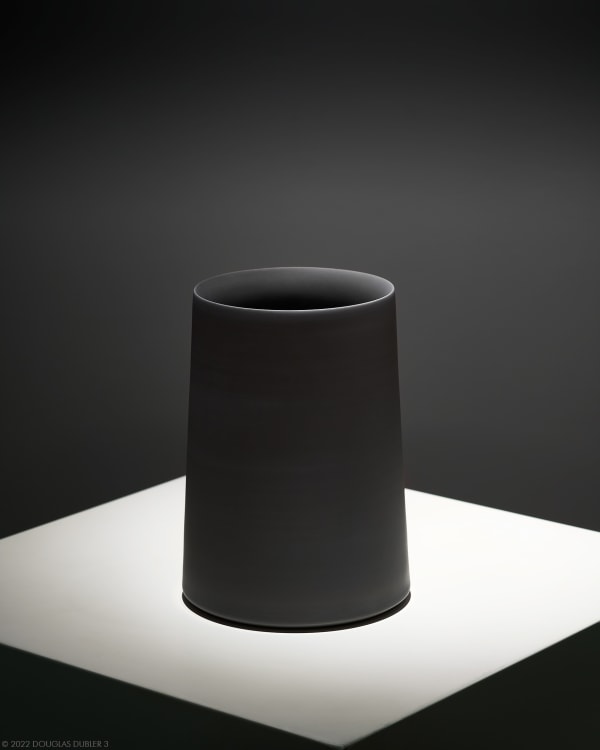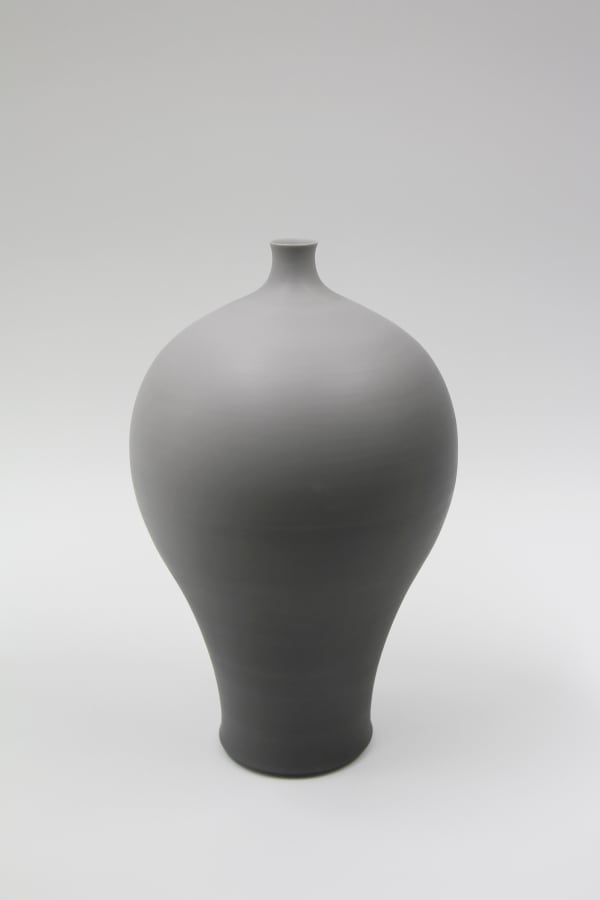-

Shin Fujihira (b. 1922–2012) came of age under the influence of his father, who established the Fujihira Pottery Company in 1916 in Gojozaka, the main pottery district in the city of Kyoto. Diagnosed with tuberculosis after the outbreak of the Pacific War, Fujihira struggled during his early adulthood, narrowly recovering from near death. Through this time, Fujihira turned towards art as motivation, and this passion was revitalizing. For Fujihira pottery was an escape from depression; an opportunity to transformation his appreciation for the joys of life.
-
 The main apprentice of the living national treasure in bizen, Jun Isezaki, Hiroshi Goseki (b. 1988) is on the frontier of innovation in the traditional and well-established bizen style. Goseki outsources no aspect of his creative process; the import of bizen clay to his studio in Ibaraki prefecture, lumber foraging, a combination of wheel-thrown and hand-built techniques, and constant refueling of a the fourteen-day kiln fire required of bizen class ceramics are all elements that contribute to the artist’s unique pieces.
The main apprentice of the living national treasure in bizen, Jun Isezaki, Hiroshi Goseki (b. 1988) is on the frontier of innovation in the traditional and well-established bizen style. Goseki outsources no aspect of his creative process; the import of bizen clay to his studio in Ibaraki prefecture, lumber foraging, a combination of wheel-thrown and hand-built techniques, and constant refueling of a the fourteen-day kiln fire required of bizen class ceramics are all elements that contribute to the artist’s unique pieces. -
 A trailblazer among a family of traditionalists, Koichiro Isezaki (b. 1974) preserves his renowned father’s Bizen techniques while simultaneously reimagining the ceramic with atypical forms. Early in his career, Isezaki apprenticed with American sculptor Jeff Shapiro. Since his return to Japan, Isezaki established his kiln in Onadacho in Gifu prefecture. He has exhibited extensively, including at the National Museum of Modern Art Crafts Gallery and the Paramita Museum, where he won the Ceramic Art Grand Prize in 2011.
A trailblazer among a family of traditionalists, Koichiro Isezaki (b. 1974) preserves his renowned father’s Bizen techniques while simultaneously reimagining the ceramic with atypical forms. Early in his career, Isezaki apprenticed with American sculptor Jeff Shapiro. Since his return to Japan, Isezaki established his kiln in Onadacho in Gifu prefecture. He has exhibited extensively, including at the National Museum of Modern Art Crafts Gallery and the Paramita Museum, where he won the Ceramic Art Grand Prize in 2011. -

Keiji Ito (b. 1935) is a ceramicist and sculptor, well known for his minimalist style and as an invaluable, inspiring mentor to younger generations of aspiring artists. Ito has won numerous awards for his artistic achievements and has exhibited in countless solo and group exhibitions. He is presently a member of the International Association of Ceramics.
-

Yukiya Izumita (b. 1966) is the leading ceramicist of Japan’s northeast Tohoku arts region. He uses origami paper techniques to construct layered sculptures that reflect the harsh seaside atmosphere. The visual lightness of Izumita’s tiered ceramics betray the salt- and iron-dense clay collected from the coastal beaches. In response to the unrelenting northern environment, Izumita’s works come to resemble the strange and natural bluff rock formations. Izumita is the recipient of the 20th Biennial Japanese Ceramic Art Exhibition’s Excellence Award and the Grand Prize at the Asahi Ceramic Exhibitions of 2000 and 2002. His pieces are in collections including the Yale University Art Gallery, the Philadelphia Museum of Art, Minneapolis Institute of Art, and Iwate Museum of Art.
-

Ryoji Koie (1938-2020) might be considered one of Japan's most forward-thinking artists of his time. Born in 1938 in Tokoname, Koie studied ceramics from a young age. Still, his bright spirit and curiosity made him a bold and experimental artist while staying true to traditional Japanese ceramic forms. His gestural application of glazes on the surface and the giant x creates a dynamic and innovative approach inspired by postwar contemporary art by artists such as Jackson Pollock. Koie won multiple awards throughout his career, including the Japan Ceramic Society Award in 1992, the Chunichi Cultural Award in 2005, and the Gold Prize for the Japan Society Award in 2008. His works can be found in permanent collections worldwide, such as the Smithsonian Museum, Victoria & Albert Museum, Centre National de Georges Pompidou, the Metropolitan Museum of Art, and the Seoul Metropolitan Museum of Art.
-

Leading ceramicist Masahiro Maeda (b. 1948) is known for glaze-painted porcelains pioneering distinctly contemporary designs. Maeda's approach to iro-e technique innovate traditional Japanese forms and color arrangements. His method of creating woven texture using paint masks produces timeless layered and overlapping surfaces. Maeda's works exhibited at the Victoria & Albert, Smithsonian National Museum, and Tokyo National Museum among many others, and are in collections of the highest caliber including the Philadelphia Museum of Art, Art Institute of Chicago, and many more. Maeda's work has led him to serve as a judge at Japan's top ceramic competitions, and his contributions to contemporary ceramic design influence generations of Japanese artists as director of Japan Crafts Association in addition to many other leadership roles at key craft institutions.
-

Educated at the Prefectural Kutani Yaki Technical Training Institute, Kiyoko Morioka (b. 1974) is certified as a traditionalcraftsperson in the porcelain Kutani technique. Known for their ornate scenes, bright colors, and silky texture, the Kutani category is decorative and vivid. Since she received her Ph.D. in 2016 from Kanazawa College of Art, Morioka has exhibited extensively in Japan. Now an Associate Professor of Art at Kobe Design University, Morioka’s placid porcelains emulate the hues of the Kanazawa sky she so cherishes.
-
 Kai Tsujimura (b. 1976) is a leading light of the generation of Japanese potters just now coming into their own. Thoroughly trained by his father, famous pottery Shiro Tsujimura, Kai embarked on his career in 2001 when he built his own kiln in the hills of Nara. Since coming into his own, Tsujimura continues exhibiting his ceramics artworks extensively in Japan and the United States. In 2010, Tsujimura’s large jar joined the Minneapolis Institute of Art’s permanent collection.
Kai Tsujimura (b. 1976) is a leading light of the generation of Japanese potters just now coming into their own. Thoroughly trained by his father, famous pottery Shiro Tsujimura, Kai embarked on his career in 2001 when he built his own kiln in the hills of Nara. Since coming into his own, Tsujimura continues exhibiting his ceramics artworks extensively in Japan and the United States. In 2010, Tsujimura’s large jar joined the Minneapolis Institute of Art’s permanent collection. -

The eldest son of the world-famous potter Shiro Tsujimura, Yui Tsujimura (b. 1975) pays special attention to natural materials and organic decorative appearances. Yui’s use of raw materials, especially charcoal ash thrown into the kiln during the firing, creates a refreshingly unique turquoise-green glaze rich with crystal and crazing patterns. Yui’s ceramics are in several impressive collections including the Metropolitan Museum of Art and the Detroit Institute of Arts.
-

The ceramic works of Kodai Ujiie (b. 1990) are refreshingly avant-garde. Since his debut exhibition in 2014, Ujiie’s colorful and abstract wares have interpolated the kintsugi lacquer mending technique and experimented with unusual celadon colors. Ujiie now works from his kiln in Tajimi, Gifu Prefecture.

















